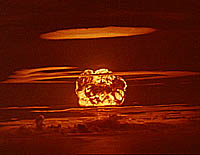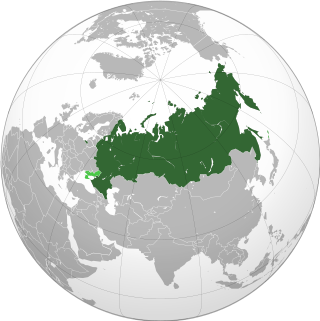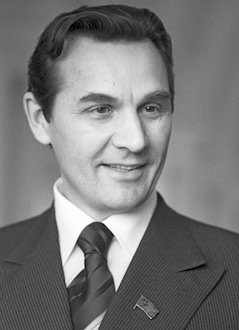Related Research Articles

Biological warfare, also known as germ warfare, is the use of biological toxins or infectious agents such as bacteria, viruses, insects, and fungi with the intent to kill, harm or incapacitate humans, animals or plants as an act of war. Biological weapons are living organisms or replicating entities. Entomological (insect) warfare is a subtype of biological warfare.

Bioterrorism is terrorism involving the intentional release or dissemination of biological agents. These agents include bacteria, viruses, insects, fungi, and/or their toxins, and may be in a naturally occurring or a human-modified form, in much the same way as in biological warfare. Further, modern agribusiness is vulnerable to anti-agricultural attacks by terrorists, and such attacks can seriously damage economy as well as consumer confidence. The latter destructive activity is called agrobioterrorism and is a subtype of agro-terrorism.

A weapon of mass destruction (WMD) is a biological, chemical, radiological, nuclear, or any other weapon that can kill or significantly harm many people or cause great damage to artificial structures, natural structures, or the biosphere. The scope and usage of the term has evolved and been disputed, often signifying more politically than technically. Originally coined in reference to aerial bombing with chemical explosives during World War II, it has later come to refer to large-scale weaponry of warfare-related technologies, such as biological, chemical, radiological, or nuclear warfare.
The All-Union Science Production Association Biopreparat was a Soviet agency created in April 1974, which spearheaded the largest and most sophisticated offensive biological warfare program the world has ever seen. It was a vast, ostensibly civilian, network employing 30–40,000 personnel and incorporating five major military-focused research institutes, numerous design and instrument-making facilities, three pilot plants and five dual-use production plants. The network pursued major offensive research and development programs which genetically engineered microbial strains to be resistant to an array of antibiotics. In addition, bacterial agents were created with the ability to produce various peptides, yielding strains with wholly new and unexpected pathogenic properties.

The Biological Weapons Convention (BWC), or Biological and Toxin Weapons Convention (BTWC), is a disarmament treaty that effectively bans biological and toxin weapons by prohibiting their development, production, acquisition, transfer, stockpiling and use. The treaty's full name is the Convention on the Prohibition of the Development, Production and Stockpiling of Bacteriological (Biological) and Toxin Weapons and on their Destruction.

The Russian Federation is known to possess or have possessed three types of weapons of mass destruction: nuclear weapons, biological weapons, and chemical weapons. It is one of the five nuclear-weapon states recognized under the Treaty on the Non-Proliferation of Nuclear Weapons and one of the four countries wielding a nuclear triad.
On 2 April 1979, spores of Bacillus anthracis were accidentally released from a Soviet military research facility in the city of Sverdlovsk, Soviet Union. The ensuing outbreak of the disease resulted in the deaths of at least 68 people, although the exact number of victims remains unknown. The cause of the outbreak was denied for years by the Soviet authorities, which blamed the deaths on consumption of tainted meat from the area, and subcutaneous exposure due to butchers handling the tainted meat. The accident was the first major indication in the Western world that the Soviet Union had embarked upon an offensive programme aimed at the development and large-scale production of biological weapons.
The National Biodefense Analysis and Countermeasures Center (NBACC) is a government biodefense research laboratory created by the U.S. Department of Homeland Security (DHS) and located at the sprawling biodefense campus at Fort Detrick in Frederick, MD, USA. The NBACC is the principal U.S. biodefense research institution engaged in laboratory-based threat assessment and bioforensics. NBACC is an important part of the National Interagency Biodefense Campus (NIBC) also located at Fort Detrick for the US Army, National Institutes of Health and the US Department of Agriculture.
Jeanne Harley Guillemin was an American medical anthropologist and author, who for 25 years taught at Boston College as a professor of Sociology and for over ten years was a senior fellow in the Security Studies Program at Massachusetts Institute of Technology. She was an authority on biological weapons and published four books on the topic.

Yuri Anatolyevich Ovchinnikov was a Soviet chemist who contributed to bioorganic chemistry and biochemistry. He was elected in 1970 as a full member of the USSR Academy of Sciences and subsequently became the youngest vice president of the academy in its history (1974-1988). He was elected to the American Philosophical Society in 1977. He was also president of the Federation of European Biochemical Societies (1984-1986), Director of the Institute of Bioorganic Chemistry in Moscow (1970-1988) and professor at Moscow State University. From 1972 through to 1984 he served concomitantly as head of the Laboratory of Protein Chemistry at the USSR Academy of Sciences' Institute of Protein.
The United States biological weapons program officially began in spring 1943 on orders from U.S. President Franklin D. Roosevelt. Research continued following World War II as the U.S. built up a large stockpile of biological agents and weapons. Over the course of its 27-year history, the program weaponized and stockpiled seven bio-agents — Bacillus anthracis (anthrax), Francisella tularensis (tularemia), Brucella spp (brucellosis), Coxiella burnetii (Q-fever), Venezuelan equine encephalitis virus, Botulinum toxin (botulism), and Staphylococcal enterotoxin B. The US also pursued basic research on many more bio-agents. Throughout its history, the U.S. bioweapons program was secret. It was later revealed that laboratory and field testing had been common. The official policy of the United States was first to deter the use of bio-weapons against U.S. forces and secondarily to retaliate if deterrence failed.

The Soviet Union covertly operated the world's largest, longest, and most sophisticated biological weapons program, thereby violating its obligations as a party to the Biological Weapons Convention of 1972. The Soviet program began in the 1920s and lasted until at least September 1992 but has possibly been continued by Russian Federation after that.

Saddam Hussein (1937–2006) began an extensive biological weapons (BW) program in Iraq in the early 1980s, despite having signed the Biological Weapons Convention (BWC) of 1972. Details of the BW program and a chemical weapons program surfaced after the Gulf War (1990–91) during the disarmament of Iraq under the United Nations Special Commission (UNSCOM). By the end of the war, program scientists had investigated the BW potential of five bacterial strains, one fungal strain, five types of virus, and four toxins. Of these, three—anthrax, botulinum and aflatoxin—had proceeded to weaponization for deployment. Because of the UN disarmament program that followed the war, more is known today about the once-secret bioweapons program in Iraq than that of any other nation.
The People's Commissariat for Agriculture, abbreviated as Narkomzem was established in the RSFSR following the October Revolution. When the RSFSR joined the other Soviet republics to form the Union of Soviet Socialist Republics (USSR), agriculture was to be an area of policy governed exclusively by the individual union republics and Narkomzem remained a Commissariat of the RSFSR and other respective Soviet Socialist Republics. Coinciding with the onset of the policy of mass collectivisation of agriculture and the Five Year Plan, it was decided to create a union-level People's Commissariat for Agriculture of the USSR in 1929 which would exist above the republic-level People's Commissariats of Agriculture. Its headquarters building was located at Orlikov Pereulok, 1, Moscow, designed by Aleksey Shchusev in 1928. Narkomzem was reformed as the Soviet Ministry of Agriculture and Food (Minsel'khoz) in 1946.
Entomological warfare (EW) is a type of biological warfare that uses insects to interrupt supply lines by damaging crops, or to directly harm enemy combatants and civilian populations. There have been several programs which have attempted to institute this methodology; however, there has been limited application of entomological warfare against military or civilian targets, Japan being the only state known to have verifiably implemented the method against another state, namely the Chinese during World War II. However, EW was used more widely in antiquity, in order to repel sieges or cause economic harm to states. Research into EW was conducted during both World War II and the Cold War by numerous states such as the Soviet Union, United States, Germany and Canada. There have also been suggestions that it could be implemented by non-state actors in a form of bioterrorism. Under the Biological and Toxic Weapons Convention of 1972, use of insects to administer agents or toxins for hostile purposes is deemed to be against international law.

Allegations that the United States military used biological weapons in the Korean War were raised by the governments of the People's Republic of China, the Soviet Union, and North Korea. The claims were first raised in 1951. The story was covered by the worldwide press and led to a highly publicized international investigation in 1952. Secretary of State Dean Acheson and other American and allied government officials denounced the allegations as a hoax. Subsequent scholars are split about the truth of the claims.
The Aral smallpox incident was a 30 July 1971 outbreak of the viral disease which occurred as a result of a field test at a Soviet biological weapons (BW) facility on an island in the Aral Sea. The incident sickened ten people, of whom three died, and came to widespread public notice only in 2002.
Operation Shocker was a 23-year counterintelligence operation run by the US Federal Bureau of Investigation against the Soviet Union. The operation involved the fake defection in place of a US Army sergeant based in Washington, D.C. who, in return for hundreds of thousands of dollars over two decades, provided information to Soviet intelligence (GRU) as agreed by the Joint Chiefs of Staff. This included over 4,000 documents on a new nerve gas the US believed unweaponizable, with the US intending to waste Soviet resources.

Rebecca Katz is a professor and director of the Center for Global Health Science and Security at Georgetown University Medical Center. She is an expert in global health and international diplomacy, specializing in emerging infectious diseases. From 2004 to 2019, she was a consultant for the United States Department of State on matters related to the Biological Weapons Convention and emerging infectious disease threats. Katz served on the Joe Biden presidential campaign's public health panel to advise on the COVID-19 pandemic.
Sergiyev Posad-6 is a major biological weapons research centre located near the city of Sergiyev Posad, Moscow Oblast, Russia. It focuses on pathogens causing hemorrhagic fever, smallpox and Ebola.
References
- 1 2 3 "Milton Leitenberg". University of Maryland . Retrieved 2020-03-21.
- ↑ Adam Taylor (2020-01-29). "Experts debunk fringe theory linking China's coronavirus to weapons research". Washington Post . Retrieved 2020-03-21.
Milton Leitenberg, an expert on chemical weapons at the University of Maryland, said he and other analysts around the world had discussed the possibility that weapons development at the Wuhan lab could have led to the coronavirus outbreak in a private email chain but that no one had found convincing evidence to support the theory.
- ↑ Milton Leitenberg (2020-06-04). "Did the SARS-CoV-2 virus arise from a bat coronavirus research program in a Chinese laboratory? Very possibly". Bulletin of the Atomic Scientists . Retrieved 2020-08-15.
- ↑ James A. Poupard (2012). "Reviews and Resources: The Soviet Biological Weapons Program—a History". Microbe . 7 (11): 533–534. doi:10.5860/choice.50-3512 (inactive 1 February 2025). S2CID 151240342.
{{cite journal}}: CS1 maint: DOI inactive as of February 2025 (link) - ↑ Tim Trevan (2012). "Military Science: The USSR's deadly secret". Nature . 489 (7416): 364–365. Bibcode:2012Natur.489..364T. doi: 10.1038/489364a . S2CID 4329448.
- ↑ Michael D. Gordin (2014). "The Soviet Biological Weapons Program: A History". The Historian . 76 (2): 409–410. Retrieved 2020-08-16.
- ↑ John R. Walker (2012). "The Leitenberg-Zilinskas History of the Soviet Biological Weapons Programme" (PDF). Harvard-Sussex Program Occasional Paper (2). Retrieved 2020-08-17.